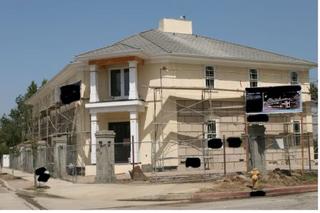Much Ado About Mansionization?

Is there a perpetual shadow hovering over your house? Do you feel as though you live in a Batman movie? You may be the victim of a neighboring McMansion or a new development trend called mansionization, the housing industry's equivalent to bigger portions and fast food.
These mansionizers—who are frequently "spec" builders--buy small or dilapidated homes, raze them and erect massive structures, often resembling sterile apartment buildings. Except for meager set-backs, they swallow up the entire lot, dwarf their Liliputian neighbors and invade the privacy of adjacent yards with their second-story windows. It's sort of like jamming five hotels onto "Baltic Avenue" and calling them a home. There simply isn't enough space without impacting the "Community Chest" and monopolizing the other players in the game.
Most U.S. building codes are "mansionization friendly." For example, Beverly Hills caps home size at 15,000 square feet, restrictive only for those who dream of adding the ever-popular indoor football field.
Los Angeles allows a 7600 square foot home on a 5000 square foot lot. This isn't fuzzy math, and the city is not saying you should re-position your neighbor's fence in the middle of the night, gaining a 2600 foot advantage for your new breakfast nook. You must build towards the sun, potentially leaving your neighbors in the dark.
McMansions are perceived by some as the answer for a "Supersize Me," SUV society that subscribes to the notion that bigger is better and that all of ones extended family—regardless of whether they are still alive—must fit neatly into ones abode, even though there are an average of only 2.5 inhabits per property in the U.S.
Proponents of these mini-castles say they increase the value of neighboring homes, help with much-needed living accommodations and are inevitable. As urban and suburban space becomes scarce, McMansions will pop up in much the same way as "more compressed" Europe is dotted with row houses.
The average size of U.S. homes has grown over the past 45 years from 1,140 to 2,225 square feet, according to a Harvard University study. The National Association of Home Builders reports that 21 percent of houses built in 2004 equaled or exceeded 3000 square feet.
These statistics boost the "inevitability" argument. The "increase in property values" assertion succeeds or fails depending on various factors, such as where ones house is situated, the nature of the community and what type of buyers are looking for homes at the time. Are they gourmets or gourmands? Do they welcome McMansions or are they afraid of monsters?
The last argument by McMansionites seems flawed. It is unclear how a gargantuan property accommodating two or three inhabitants, as statistics indicate, aids the ever-increasing demand for housing. Mansionization's "contribution" seems more likely to reinforce the image of America as a land of over-consumption and spotlight the gap between the rich and middle class.
Outraged neighbors in the California communities of Valley Glen, Sunland, Tujunga, Menlo Park, Del Mar, and Valley Village--and outside of California in Connecticut, Illinois, Pennsylvania, New Jersey, Maryland and Massachusetts--convene with local officials to discuss how to halt these stucco intruders, their goal being to implement moratoriums and anti-mansionization ordinances.
Their arguments typically hinge both on objective and subjective factors. In addition to problems associated with a loss of privacy and sunlight, many seek to retain the character and architectural tone of their neighborhoods. They argue that the "David and Goliath" disparities and lack of pleasing curves on many of these "architecturally challenged" monstrosities make their communities less aesthetically appealing. Criticism of the "boxy" look is all too common.. But what if some people--such as McMansion shoppers--cherish the boxy look?
Should government dictate taste, ruling whether a structure is a fairy princess, a plain Jane or an ugly stepmother? Are Building and Safety employees—usually ex-contractors—experts on charm and color coordination? Will art school graduates have to take their place? New ordinances could force homeowners to hire "housing stylists," in much the same way as Cher and Cameron Diaz employ wardrobe aides and makeup artists.
Do we want to forfeit individuality, self-determination and the freedom to do as we please with our single family dwellings, all in exchange for neighborhood uniformity? After all, architectural consistency—as well as Big Brother—can be found in the condo complex or gated community. C, C & R's can impose fines on those who paint their doors red, have garage sales or allow their over-eating poodle to breach the "doggie weight limit."
Local government must resist the temptation to formulate aesthetically-based rules; however, this does not preclude activist neighbors from boycotting certain builders and educating buyers about the merits associated with rejecting "trophy houses" comprised of cheesy materials. McMansion supply hinges on McMansion demand.
Many builders construct quality products with style, grace and concern for residents of the area. They must be encouraged while less considerate developers should be brought into dialogue with local councilmembers and the stakeholders in the community.
In the end, it's not a matter of "much ado, " but a matter of much to do.
___________________
To see Charlotte Laws' proposal regarding mansionization in Los Angeles, go to www.CharlotteLaws.org and click on "Articles" link.
The real estate websites for Charlotte Laws are www.YourTopBroker.com and www.CharlotteLaws.com


1 Comments:
Very interesting, as always Charlotte Laws. It's so refreshing to get other people’s perspectives on so many different aspects of southern living at home catalog. Has it always been like this?
Post a Comment
<< Home